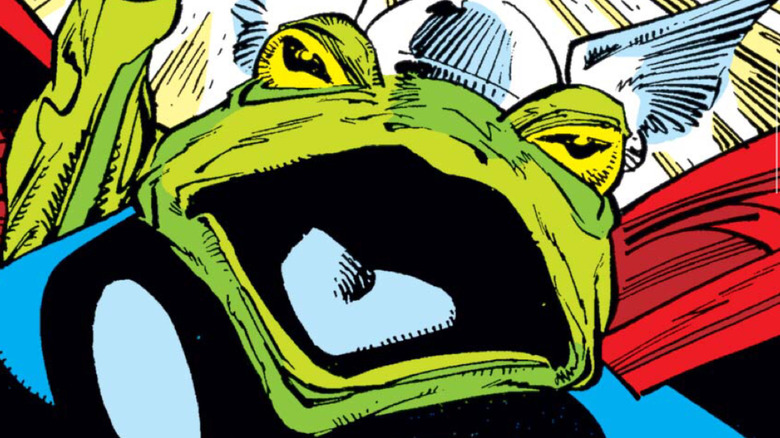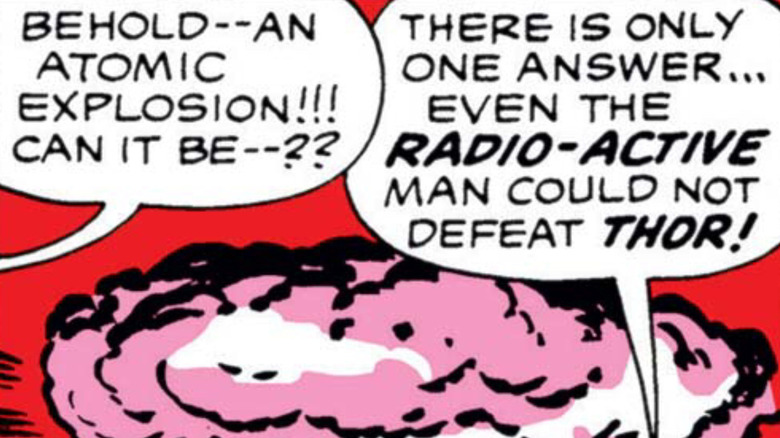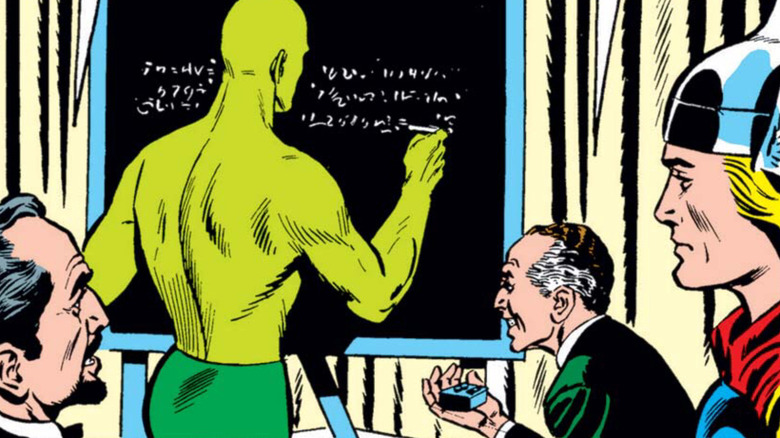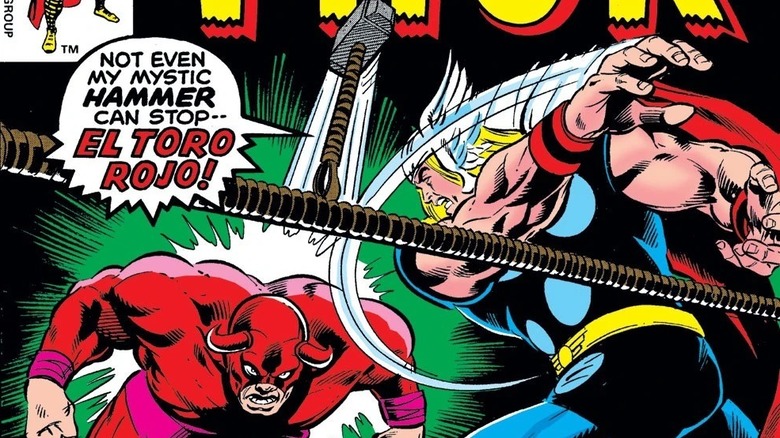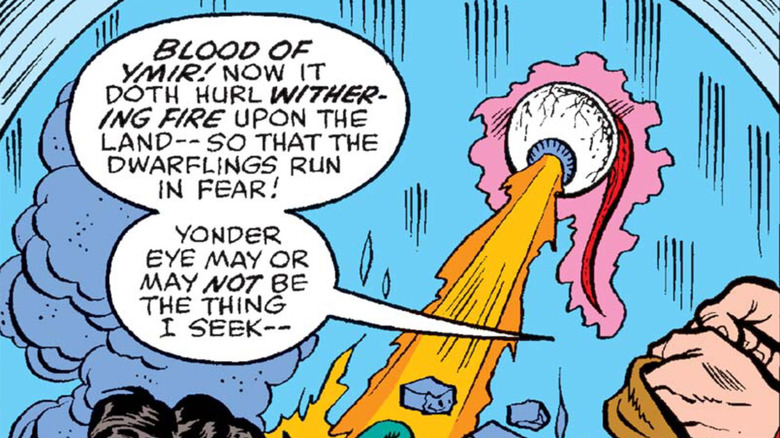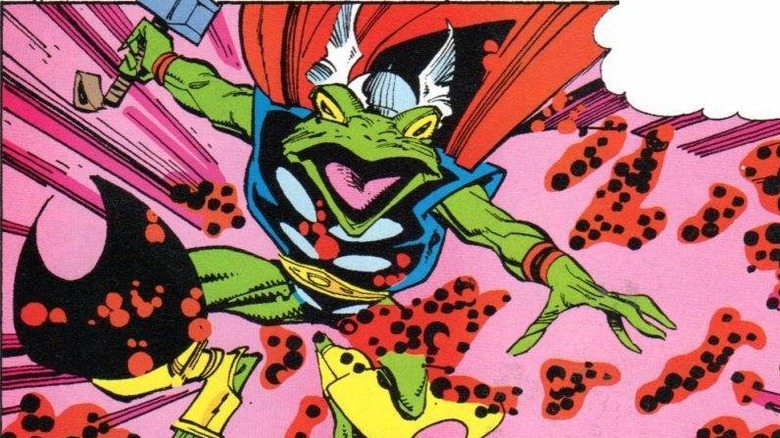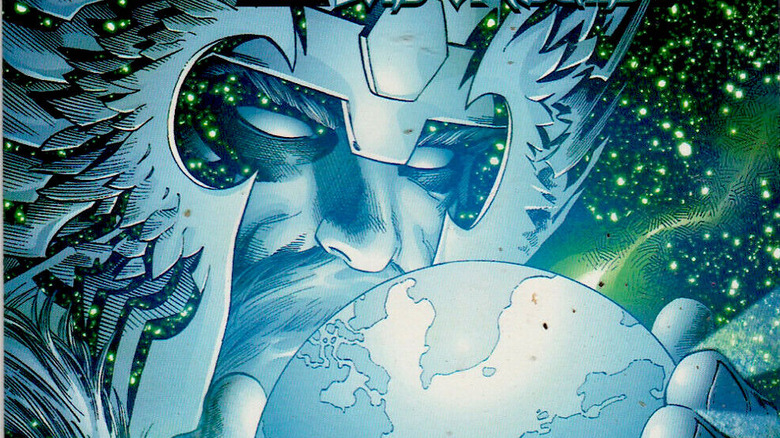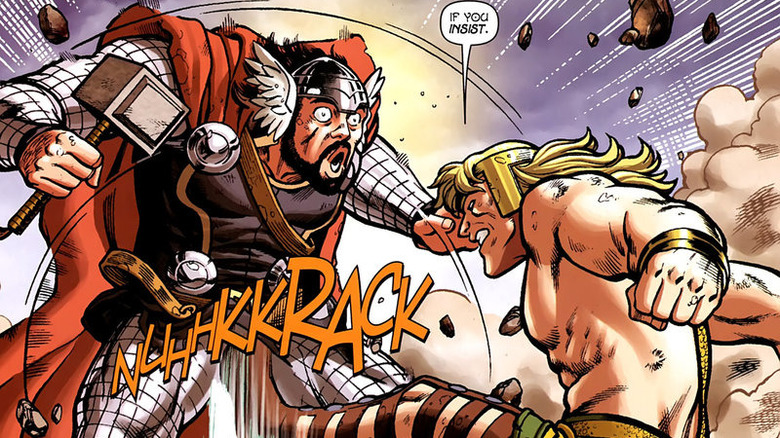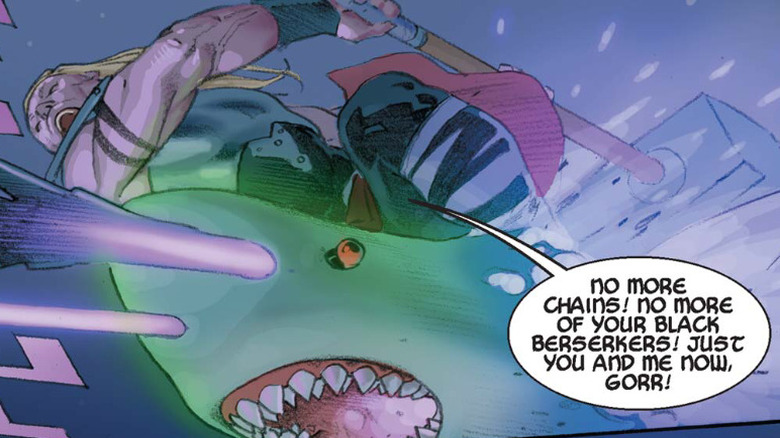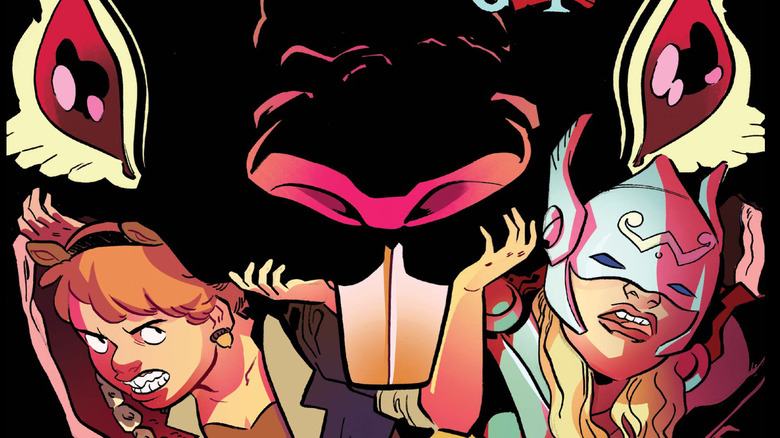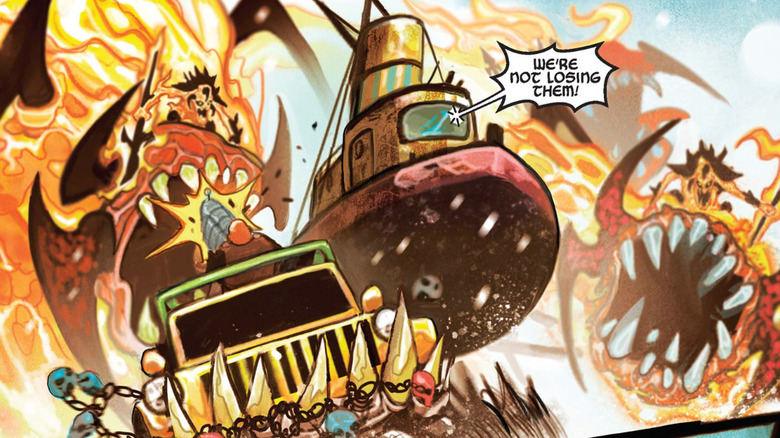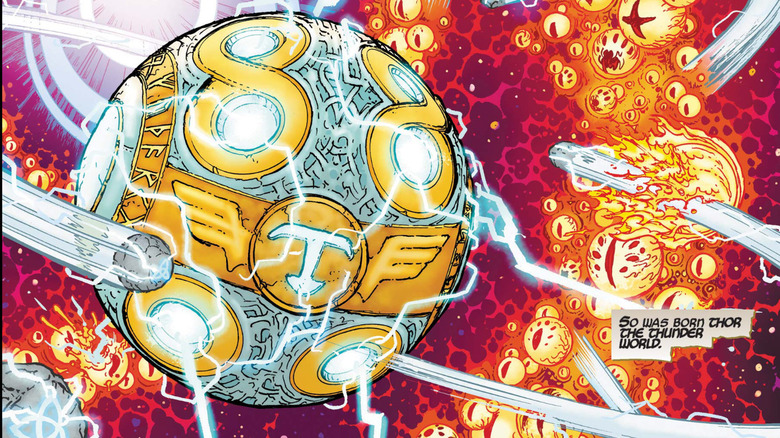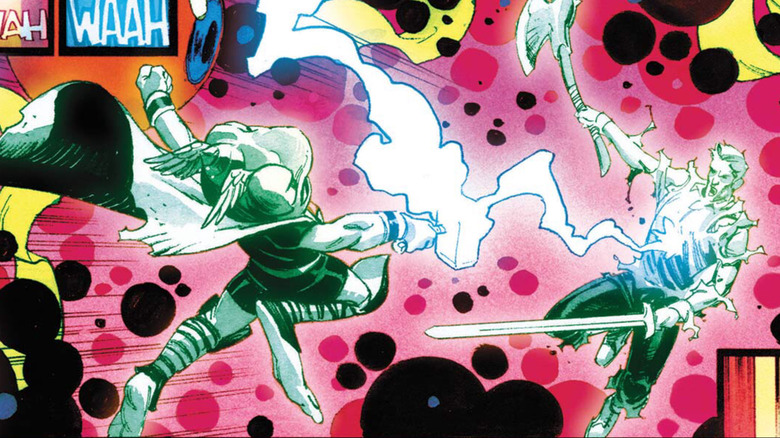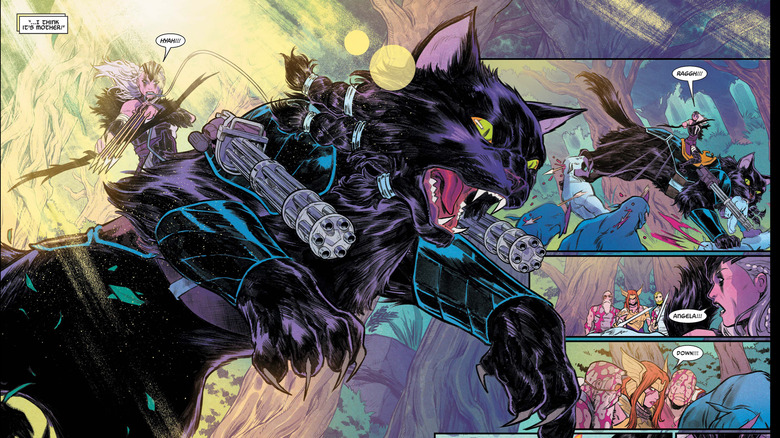The Weirdest Thor Comic Book Stories Of All Time
The "Thor" series has provided some of the most surreal moments in the Marvel Cinematic Universe, from a chase interrupted by interdimensional portals to the Dark Elves' charcoal-based technology, from Loki casting Matt Damon as himself to glam Jeff Goldblum to cyborg barber Stan Lee to a soft-spoken rock-monster revolutionary who failed because he didn't print enough pamphlets. But even that's just scratching the surface of the many bizarre adventures the God of Thunder's gotten up to in the comics (which in turn is just scratching the surface of his strange mythological adventures, but that's another story for another day).
Since Stan Lee and Jack Kirby first dropped the legendary deity into the Marvel Universe sixty years ago, Goldilocks has zigzagged across the strangest corners of time and space and met characters as colorful as Ego the Living Planet; Galactus, the Devourer of Worlds; the High Evolutionary, and his animal men; and a space horse who stole his powers. And these are some of his less obscure opponents — you can only imagine what kind of stories had to be too weird for Thor fans to latch onto. Or rather you don't have to, since we've scoured thousands of pages of comics to bring you Thor's strangest adventures.
The one where Thor nuked China
Stan Lee and Jack Kirby were never shy about tackling political issues in their comics, but their allegiances changed greatly over their run. As the '60s wore on, they'd integrate the comics with characters like the Black Panther and involve Spider-Man in the student protest movement. Thor's early adventures in "Journey Into Mystery" (1952) portray him as a true Cold Warrior. Instead of the cosmic and mythological threats he'd later fight, he'd spend every other issue deposing some Communist regime or other.
Few of the international incidents Thor caused can compare to "Journey" #93, which introduced readers to Radioactive Man — not Bart Simpson's favorite superhero, but Chen Lu, a Chinese scientist who deliberately exposes himself to deadly amounts of radiation. Comics being comics, instead of getting cancer, he absorbs it all into his body, enabling him to melt bullets in midair and deflect Thor's lightning bolts.
Somehow, it also gave him psychic powers that force Thor to toss his hammer into the Hudson turning him back into his human alter ego, Dr. Don Blake. When Blake recovers the hammer, he uses it to make a whirlwind that transports Radioactive Man all the way back to China, just as he's about to nuke New York. That means a big ole mushroom cloud right in front of a badly-drawn Chairman Mao's balcony. Somehow, his reaction is to duck instead of running for the hills before the fallout can level Beijing. Equally baffling, the headline the next morning is "Thor Rids City of Radio-Active Man" and not "Thor on Trial at the Hague for War Crimes."
The one where Thor's alter ego built a superpowered robot
Stan Lee populated the Marvel Universe with a variety of super-scientists — Reed Richards, Tony Stark, Doctor Doom, Doctor Octopus, etc. But just as comic book science is miles away from real science, comic book scientists operate very differently from real scientists. In our universe, it takes a lifetime to master just one field. In the Marvel Universe, biologists can build time machines, astrophysicists can make clones, and radiologists can build robots.
None of these characters strain credulity quite as much as Doctor Donald Blake. He was never portrayed as more than an ordinary, if accomplished, physician, with a few baffling exceptions. His MD somehow taught him to build an X-Ray machine that found his hammer at the bottom of the East River in his fight with Radioactive Man. But that's nothing next to "Journey" #95, where Thor shows up to a "Young Frankenstein"-style black-tie event to introduce his alter ego's latest invention.
It's not just a fully functional machine man — somehow Blake also invented an "impenetrable plastic tissue" to build it and gave it a super-genius computer brain. Makes you wonder why he sticks around his medical practice instead of just collecting the billions of dollars in royalties for his invention.
The one where Thor became a luchador
In Thor (1966) #290, Thor takes a break from writer Roy Thomas's long-running Celestials Saga to settle a grudge match between the Eternal luchador El Vampiro and his Deviant opponent El Toro Rojo. Apparently, the Lucha Libre phenomenon hadn't quite taken off in the States yet, since Thomas inserts a footnote explaining, "Masked wrestlers have been extremely popular in Mexico and other Latin American countries for several decades." El Vampiro's Eternal strength made him the undisputed champion until El Toro Rojo showed up with his even greater Deviant powers, and he's happy to continue the war between their respective peoples by taking the fight out of the ring and into El Vampiro's home.
Thor defends his Eternal host, but in the process loses his hammer, transforming him back into Donald Blake and it back into a walking stick. El Toro Rojo decides to keep the stick for himself, and Blake chases him back to the arena, where he's about to use Blake's cane to beat up an opponent named El Halcon D'Oro (The Golden Falcon, in bad Spanish), who, of course, is dressed in green. Blake disguises himself with a handkerchief before he enters the ring, technically making him a masked luchador (lucha-Thor?). Once he's recovered his cane and his immortal form, Thor takes down El Toro Rojo in a free-for-all brawl over the referee's objections. He even manages to combine two sports when he distracts El Toro with his cape like a matador.
The one where Odin's eyeball took Thor on a trippy journey through Asgard's past
The most recognizable feature of both the mythological and Marvelogical version of Thor's father Odin is his one eye. So it was a surprise to find he didn't lose his other one until 16 years into the series, when in #274 Odin sacrificed it to the flaming head of his uncle Mimir for information that could prevent Ragnarok, the cataclysm that would destroy Asgard. Thor would later discover this wasn't the first time Asgard faced annihilation, and his teacher was, of all things, his father's eyeball. After Odin plucked it out, it took on a life of its own, as Thor learns in #292, when he finds it in a prog-rock cover tableau shooting fireballs at a village of Keebler-ready dwarves.
It only gets weirder from there, as Odin's eyeball (who always spells "I," "eye," a bit that takes exactly two pages to get old) reveals the Asgard we know wasn't the original model. In #293-94, the eyeball shows Thor the godly realm's predecessor millennia ago, which Roy Thomas and artist Keith Pollard use to correct some of previous comics' discrepancies from the myths, showing the first incarnation of Thor as a bearded redhead and including previously absent gods like Thor's sons Magni and Modi and his brother Vidar. A handful of gods survive as the ruined Asgard regrows into a lush Eden, where in one psychedelic sequence, Odin's surviving sons and brothers find his magic spear Gugnir, which merges them all into a new Odin.
The one where Loki turned Thor into a frog
Writer-artist Walter Simonson is responsible for some of Thor's most epic stories, but he also knew how to have fun with it. In "Thor" #363, after the death of Odin, Loki takes his brother off the table as a rival for the throne by, in a clever reversal of the fairy tale, having a woman kiss him into a frog. That would be enough weirdness for most writers, but Simonson continues for the next three issues, as the frogified Thor gets involved in a war between rats and frogs for control of Central Park. Rats try to poison the reservoir, Thor meets New York's legendary sewer gators and finds them controlled by a man with a magic flute, and learns that his froggy friend Puddlegulp was also the victim of a curse. Simonson almost seems to be having too much fun with chapter titles like "Thor Croaks" and the cover blurb for #366, "What do you call a 6' 6" fighting mad frog?" (the answer: "Sir!"). Once Thor regains his hammer, the thunder god turns into a hybrid frog-Thor and returns to Asgard. Loki tries to complete Thor's transformation and quickly realizes his mistake when he finds he can't reason with a wild animal and restores his brother.
The Frog Thor concept was such a fan favorite that he eventually returned in "Lockjaw and the Pet Avengers," where Puddlegulp discovers a splinter of Mjolnir that gives him the thunder god's powers. The first issue also revealed Puddlegulp's human name. That name? Simon Walterson.
That time Thor took over the world
Thor refuses the throne after being regaining his divine form. But in "Death of Superman" writer Dan Jurgens' run, Thor takes to the throne too eagerly. In "Thor" (1998) #50, Thor declares his intentions as ruler by moving Asgard to the skies of New York, and starts acting progressively more like the god of all earth, performing miracles, overthrowing governments, and attracting worshippers.
Naturally, this makes earth's political and religious leaders nervous, and in #66 an international alliance launches a strike on Asgard in his absence, destroying both it and New York in the process. In the chaos, Thor kills his human side (in comics, metaphors can be literal), and becomes unworthy to lift Mjolnir.
Even this, and the fact that his pure-hearted brother Balder, his wife Sif, and his Avengers teammates all turn on him while Loki happily joins him, do nothing to sway him. In #70, the subtitle changes from "Lord of Asgard" to "Lord of Earth," and we jump forward to see the effects of his reign. Loki has turned the earth into a police state, and we learn in #70 that Thor's response to wars in the Middle East was simply to redraw all the borders and outlaw all religions except worship of himself. It was all timely stuff at the turn of the century, as the United States was flexing its international muscles during the War on Terror: Thor even appoints Loki Head of Security in reference to the newly formed Department of Homeland Security.
The one where Thor and Hercules switched places
Thor's Olympian counterpart Hercules had his greatest moment in the spotlight when writers Greg Pak and Fred Van Lente turned "The Incredible Hulk" into the "Incredible Hercules" in the aftermath of "World War Hulk." And one of their most memorable stories brought Thor and Herc back together, in their own unique way.
In #132, Hercules meets Balder, current ruler of Asgard, who's been forced to exile Thor after Loki tricked him into killing his grandfather. But Balder needs Thor to prevent the Queen Alflyse of Svartalfheim from conquering the other realms, so he calls in Hercules as a substitute, disguising him in Thor's armor. Except "Balder" is really Svartalfheim's once and future king Malekith the Accursed (which savvy readers might have seen coming since his costume's twenty years out of date).
Unlike the real Thor, Hercules can't resist the pleasures of the flesh, and he ends up eating, drinking, and screwing his way into marriage to Alflyse, who he finds expecting him to lead the invasion he'd been sent to prevent. Fortunately, the real Thor shows up, but to keep the Dark Elves from retaliating for Hercules' deception, he wears his own disguise, leading to #136's promise of a battle between "Hercuthor" and "Thorcules."
Thor-as-Hercules challenges Hercules-as-Thor on behalf of Asgard, and we see they're not afraid to fight dirty, as shown with sound effects like "NUHHKKKRACK!" "HWWWEDGIE!" and "NURP!" (written in purple, of course). Hercules loses, which is just fine by him even if he has to ice his groin, because he not only prevented war, as far as everyone watching is concerned, "Hercules" won.
The one where Thor rode into battle on a space shark
Few "Thor" runs are as packed with weirdness as Jason Aaron's seven-year tenure — the man wrote a whole miniseries called "Weirdworld," after all. One of his favorite methods of introducing strangeness is mashing together aspects of the Marvel Universe and/or stuff everyone's inner 12-year-old loves, including but not limited to Frankenstein's Murder Circus, dandy gunslinger elves, and, of course, space sharks.
Aaron's run began in 2012 with artist Esad Ribic on "Thor: God of Thunder," which introduced "Love and Thunder" villain Gorr the God Butcher in a story spanning Thor's past, present, and future presenting him with a threat so dire that it took all three versions of him to suceed. Issue #8 revealed that starsharks swarm around Gorr's divine slaughterhouse, feeding on the remains of dead gods Gorr throws into orbit. Well, to paraphrase the great Russian author Anton Chekhov, if on one page you have placed sharks circling a planet, then a hotheaded young thunder god needs to slap his future self in the face with one in the next — because that's exactly what happens when Young Thor escapes Gorr onto the other Thors' flying longboat.
Young Thor wasn't done with the celestial fish either. When Gorr uses his shapeshifting weapon Allblack the Necrosword to conjure up a dragon to swallow the present and future Thors, Young Thor saves them by trying to wrangle a starshark, and riding it into battle against the Butcher. Obviously, no adaptation would be complete without this awesome image, and "Love and Thunder" director Taika Waititi was quick to assure fans the critters will be appearing in his latest.
The one where Thor teamed up with Squirrel Girl to fight a squirrel monster
It's a safe bet that any story involving a character named Squirrel Girl, AKA Doreen Green, is going to be a weird one, and writer Ryan North and artist Erica Henderson made sure to keep the strangeness up when they brought both the male and female Thors into the series in "Unbeatable Squirrel Girl" Vol. 1 #6–8. The storyline starts out with a bang when pride of escaped lions attacks the Bronx Zoo, but before Squirrel Girl can intervene, a new hero arrives — Girl Squirrel!
Except the adorably dressed rodent isn't a hero at all. She's Ratatoskr, the Asgardian God of Discord, who, with a few well-placed whispers, turns the entire city of New York against each other. With the power of Wikipedia, Nancy identifies their enemy and goes to the Thors for help, finding them in the middle of a diner brawl over pancakes vs. waffles.
While Squirrel Girl stays behind to fight Ratatoskr, Nancy follows the Thors to Asgard to rebuild the cage the monster escaped from and, along the way, introduce the Golden Realm to Bluetooth. She also introduces the gods to her Cat Thor comics. Loki (who, of course, was responsible for the whole mess) loves them so much he turns himself into Nancy's creation. Thor, not so much.
Loki eventually saves the day and sends Ratatoskr back to her Asgardian prison, but she'd be back for the "War of the Realms" crossover in "Unbeatable Squirrel Girl" Vol. 2 #43-46, where she helps Doreen fight a giant invasion in Canada and takes the human alias "Rachel T. Oscar."
The one where Thor drove a Mad Max monster truck to an underworld wedding
Back in Thor's own book, Malekith's War of the Realms extends to an invasion of the underworld by his allies in the Fire Realm of Muspelheim in "Thor" (2018) #1–4. Thor and Loki arrive to find Balder behind the wheel of a monster truck Immortan Joe would kill for, with huge spiked wheels and a grill decorated with human skulls and animal horns. That's far from the only unorthodox transportation in this storyline, which also features a pirate ship bristling with laser cannons, Thor's brother Tyr on a T. Rex, the fire queen Sindr riding a rhino made of lava, and a train transporting Malekith's secret weapon, whose driver sings along with Black Sheep even as it goes crashing into a river.
That secret weapon turns out to be Hel's original queen, Hela, and in order to unite the underworld against Malekith, Thor arranges a wedding between her and the usurper Balder. Predictably, it descends into chaos, in between the invading fire goblins, Loki killing Thor so he can find the undead warriors of Valhalla, and Thanos, who arrives apparently to object to the union after Aaron established his relationship with Hela in "The Unworthy Thor." Instead, he breaks up with her and peaces out. All this, plus Thor's murder-happy pet Helhound Thori declaring himself "the best flower girl in Hel" and Loki pouting that Thor trusted his goat to drive the truck instead of him, all beautifully rendered with the psychedelic art of Mike Del Mundo. Hela refuses to marry Balder, and in the end, his lover Karnilla the Norn Queen squares the circle by marrying Hela herself.
The one where we went on a trippy journey through Thor's future
Jason Aaron's strange and epic run demanded a fittingly strange and epic conclusion, and that's what he give it with over a dozen artists in "King Thor" #4. After concluding his story of Thor in the far future fighting the returned God Butcher and the looming death of all existence, Aaron pulls back to the present in the Library of the Gods in Omnipotence City, where Shadrak, one of the captives Thor rescued from Gorr, is poring through the stories of his savior's past and future adventures.
First, we see "when the great holy houses of the cosmos have forged a treaty to bring an end to the age of pantheonic wars" and Thor becomes God Cop, arresting rogue deities for grand apostle larceny and illegal use of plagues, and wrecking the shark-drawn cart of two be-haloed seahorses named Icky and Wicky, Gods of Contraband.
Even later, after the 1,000 Nights of Ragnarok, demons have become powerful enough to possess whole galaxies, and Thor has adapted to the times, becoming "Thor the Thunder World," a sentient planet who flings "rune moons" instead of hammers at his enemies. Later still, Thor is brought back down to man size and lost in the ice jungles of Jotunheim, becoming "Lord of the Ice Apes," all while having an anatomically improbable love affair with a Frost Giant.
The head librarian tells Shadrak to get back to work elsewhere in the library, but he comforts himself that "There will always be more Thor stories" under a towering shelf of books of classic storylines as Aaron passes the torch to his successor, Donny Cates.
The one where Donald Blake tried to exterminate every Thor
The weirdness quotient of "Thor" took only a small hit when Donny Cates took over, and his "Prey" storyline with artist Nic Klein in "Thor" (2020) #9–14. You'll remember Dr. Donald Blake from the beginning of this list — since then, "Thor" (1966) #254 had revealed he never really existed, but was an illusion created by Odin to teach Thor humility. And in "Prey," that knowledge drives him "rather majestically insane."
He begins by destroying the idyllic suburban limbo Odin created for him, killing its guardian dragon and making its skin into armor. Thor discovers all this when he looks to Don for a little perspective now that he's been crowned King of Asgard once again, allowing Blake to trap him in limbo, transport the entire population of Asgard to "the farthest place from the fields we know," and go on a Thor-killing spree. This means the return of Frog Thor, now more badass than ever, gorily escaping from Don's mouth when he tries to swallow the amphibian whole. This is all the more hilariously incongruous since Klein has also made him cuddlier and more cartoony than ever and teamed him up with the equally cuddly interdimensional bulldog Lockjaw.
But Blake makes the fatal mistake of taking out his anger on the World Tree, allowing Thor to escape from limbo and clobber him. The battle won, Thor hands Blake over to Loki, who puts him in the same prison where Odin once left Loki himself, with a snake dripping venom in his face for all eternity.
The one where Thor's mom showed up with cat-mounted Gatling guns
Throughout Cates' run, Thor struggles to find out why his hammer has turned against him, and in #16, he thinks he's found some help in the form of a summons from his mother Freyja to the Singing Forests of Vanaheim. When he gets there, he finds his father instead, but before they can have it out over their many disagreements, an eight-eyed monster something like a white-haired rhino bursts out of the woods.
Fortunately, Freyja does arrive and decapitates the beast with a sword about two or three times her size. But that's nothing next to the imagery Michele Bandini introduces in the next issue when the rest of the herd arrives and Freyja saddles her elephant-sized black cat, with braids in its hair and Gatling guns on each shoulder. She explains that even though she had once been the goddess of marriage, with her own marriage to Odin on the rocks, she's had to find a new role as god of the hunt. We figure if you're going for a job like that, you could do a lot worse than go hunting on a heavily armed housecat.
